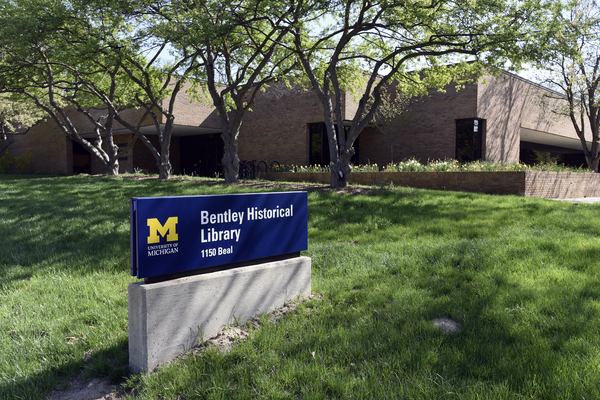The Canterbury House records contain the records of the Episcopal Student Foundation and the Canterbury House, the Episcopal Campus Church at the University of Michigan in Ann Arbor, Michigan. The records are divided into four series: History and Background Materials, Episcopal Student Foundation Board of Trustees, Staff, and Canterbury House series.
In 1883, Bishop Samuel Harris, Bishop of Michigan for the Episcopal Church, proposed creating an Episcopal Student Church at the University of Michigan. He wanted to create a forum to host discussions regarding religion and science, in direct response to debates on the theory of evolution. Fundraising began in 1883 in cooperation with Saint Andrew's parish in Ann Arbor. Gordon W. Lloyd was commissioned to design the auditorium. Construction began in 1886 and was completed in 1887. The Hobart Guild (named for bishop John Henry Hobart) was established to manage the Harris Hall. It served as a lecture hall, hosted concerts, and served as a gathering place for the community with a gymnasium, bowling alley, and billiard room. Until 1935, the parish of St. Andrew's, the nearest Episcopal Church, oversaw the activities of the Hobart Guild and the Hall. In 1935, the Church began to employ a full time Counselor for Women's Students and in 1939, it employed a full-time Chaplain. In 1943, Harris Hall was converted to a USO for servicemen training at the University and was later leased to the University for the Band and Wind Instrument Departments.
After the war, members of the Episcopal Diocese of Michigan, St. Andrew's Church and other lay members and clergy formed the Episcopal Student Foundation (ESF) board. The ESF is a formal and separate vehicle for Episcopal student work at the University of Michigan. In the summer of 1946, the board hired its first full time Chaplain independent of St. Andrew's perish. In 1947, the Board bought a property at 218 North Division Street, directly across the street from St. Andrew's Church. This house became known as Canterbury House and Episcopal student ministry continued operating there through the 1960s. In 1953, the ESF Board was given ownership of a portfolio of stocks called the Church-Nichols Trust. The presence of this Trust gave the Board a much larger and secure budget.
Canterbury House has operated under a few different names at different locations over the years with the same mission at each location – provide a space for students to explore spirituality, community, and social justice. It was a coffee house, a soup kitchen, and counseling center. The coffee house on Maynard Street in downtown Ann Arbor – known simply as Canterbury House – operated from 1967 until 1971.
The first iteration of the coffee shop began in 1965 under Reverends Dan Burke and Martin Bell. They organized the North Division location into a café, open during the week for coffee, music performances, and free food. The success of this enterprise led them to purchase the old print shop on Maynard Street, which was both larger and closer to central campus. There, it functioned as a campus ministry and coffee house during the day and converted to a concert hall on the weekends. The venue attracted a great deal of attention and nationally recognized performers like Odetta, Joni Mitchell, Neil Young, and Gordon Lightfoot. The ministry represented a convergence of the Civil Rights movement, advocacy, and the traditional role of the Church. After 1971, Canterbury moved back to 218 North Division Street, closing the coffee house on Maynard Street due to financial pressures.
In the 1970s, the ministry supported the growing gay liberation movement and was the site for LGBTQ support groups. In 1975, the Canterbury House Gayness and Spirituality group formed for "people of any spiritual path who relate positively to their own gayness" (in the groups on words). This group aimed to make LGBTQ students at the University feel accepted, especially by a religious institution, while homosexuality was still considered actively prosecuted by law in the United States. In 1978, hoping to invigorate the student body and the ministry as they had in the 60s, the House moved to a location on South State Street and became Canterbury Loft. Though the Loft was the site of poetry readings, theater performances, and concerts, it did not garner the same level of publicity the Coffee House had in the past. In 1984, Canterbury once again moved back to their old location across from St. Andrew's and was again called Canterbury House.
The chaplaincy of Reverend Dr. Virginia Peacock beginning in 1987 represented another big change for the ministry. As a female chaplain, Peacock took a special interest in women's issues, especially the role of women in the church. Peacock was interested in bringing more academia to Canterbury House. In the 1990s, she helped found the Institute of Public Theology (not to be confused with the Institute of Public Theology, an unaccredited theological school in Florida). When the Reverend Matthew Lawrence replaced Peacock in 1996, he took over the Institute and focused on coupling music with worship. He began inviting musicians to accompany masses that eventually led to a highly successful Jazz Mass. The focus of the Canterbury House after the departure of Reverend Lawrence was sustaining the ministry's Jazz Mass and on fundraising.
Canterbury House is still the campus ministry for the Episcopal Church for the University of Michigan. The ministry maintains an active social justice presence and hosts free "no-strings" meals for students in addition to concerts, sound and silence ministry events, and community organizing events.
